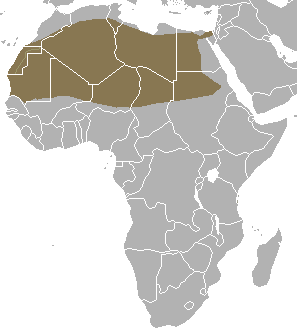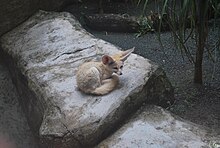The fennec has a life span of up to 14 years in captivity and about 10 years in the wild. Its main predators are the African varieties of eagle owl, jackals, and other large mammals. Families of fennecs dig out dens in the sand for habitation and protection, which can be as large as 120 m2 (1,292 sq ft) and adjoin the dens of other families. Precise population figures are not known but are estimated from the frequency of sightings; these indicate that the animal is currently not threatened by extinction. Knowledge of social interactions is limited to information gathered from captive animals. The species is usually assigned to the genus Vulpes; however, this is debated due to differences between the fennec fox and other fox species. The fennec's fur is prized by the indigenous peoples of North Africa, and in some parts of the world, the animal is considered an exotic pet.
Description
The fennec fox weighs about 0.7–1.6 kg (1.5–3.5 lb), with a body length of between 24–41 cm (9–16 in); it is around 20.3 cm (8 in) tall. A fennec Fox has a bushy tail that measures 17–30 centimeters [3] It is the smallest species of canid in the world.[4] The tail has a black tip and is 18–31 cm (7–12 in) long, while the ears can be between 10–15 cm (3.9–5.9 in) long.[5][6][7]The coat is often a cream colour and fluffy, which deflects heat during the day and keeps the fox warm at night.[3] The fennec's characteristic ears are the largest among all foxes relative to body size,[3] and serve to dissipate heat, as they have many blood vessels close to the skin.[8] The ears of a fennec are sensitive enough to hear prey that may be underground;[5] the soles of its feet are protected from the hot desert sand by thick fur.[3]
Taxonomy
In captivity
Physically, the fennec has the musk glands of other fox species, but in lesser quantity.[10] It has only 32 chromosome pairs, while other fox species have between 35 and 39. The species also displays behaviors uncharacteristic of foxes, such as living in packs while most other fox species are solitary.[10]
| ||||||||||||||||||||||||||||||||||||||||||||||||||||||||||
Behavior
Social behavior
Two fennec foxes
Information on fennec fox social behavior is mainly based on captive animals. The basic social unit is thought to be a mated pair and their offspring, and the young of the previous year are believed to remain in the family even after a new litter is born. Playing behavior is common, including with adults of the species.[13] Fennec foxes make a variety of sounds, including barking, a purring sound similar to that of a domestic cat, and a snarl if threatened.[14]
Captive animals engage in highly social behaviors, typically resting while in contact with each other. Males tend to show more aggression and urine-marking around the time of the females' estrous cycle. They have been seen to bury feces by pushing soil with their noses or hind feet when in captivity. Much remains unknown of their basic ecology and behavior in the wild, and a 2004 report by the International Union for Conservation of Nature stated that "in-depth study of the species, with particular emphasis on habitat use and population dynamics in the wild, is overdue."[13]
Diet and hunting
The fennec fox is an omnivore.[15] Food sources include rodents, insects, birds, eggs,[5] and rabbits.[16][17] An individual can jump up to 2 ft (61 cm) high and 4 ft (120 cm) forward, which helps it catch prey and escape predators.[3] When hunting, large-eared foxes such as the fennec, or the bat-eared fox, can seem to stare at the ground while they rotate their heads from side to side to pinpoint the location of prey, either underground or hidden above ground.[8] There are reports that fennec foxes climb date palms while foraging for fruit; however, some experts consider these reports unlikely unless low branches are available for support.[18]
The species can live without free water, as its kidneys are adapted to restrict water loss. A fennec's burrowing can cause the formation of dew. They are also known to absorb water through food consumption, but will drink water if available.[5]
Reproduction
Male fennec mounting a female
Gestation is usually between 50 and 52 days, although there have been 62- and 63-day gestation periods reported from foxes in captivity. The typical litter is between one and four kits, with weaning taking place at around 61 to 70 days.[13] When born, the kit's ears are folded over and its eyes are closed, with the eyes opening at around ten days, and the ears lifting soon afterward.[20] The lifespan of a fennec fox has been recorded as up to 14 years in captivity.[13]
Habitat
The species is found in North Africa and Asia. The range is from Morocco through to Egypt, as far south as northern Niger, and as far east as the Sinai Peninsula, southwestern Israel (Arava Desert)[22] and the Arabian Peninsula. [23]A fennec fox's typical den is dug in sand, either in open areas or places sheltered by plants with stable sand dunes considered to be their ideal habitat. In compacted soils, dens can be up to 120 square meters, with up to 15 different entrances. In some cases different families interconnect their dens, or locate them close together. In soft, looser sand, dens tend to be simpler with only one entrance leading to a single chamber.[13]
Population
The fennec fox is listed as least concern on the IUCN Red List,[1] and as a CITES Appendix II species: species not necessarily threatened with extinction, but whose trade must be controlled to avoid utilization incompatible with their survival.[24][25] It is often hunted by humans, though it does not cause any direct harm to human interests, such as livestock.[5] Like other foxes, it is prized for its fur by the indigenous people of the Sahara and Sinai.[26]Current statistics on population are not known, but the population is assumed to be adequate based on observations of traders commonly trapping fennec foxes in Northern Africa for exhibition or sale to tourists. In southern Morocco, the fennec fox is commonly seen in sandy areas away from permanent human settlements.[11]
Predators
The fennec fox's main predators are the various African varieties of eagle owl.[20] Other possible predators include caracals, jackals, striped hyenas, and the Saluki, a greyhound-like domestic dog local to the area. However, fennec foxes are considered very difficult to capture, and reports of predators other than the eagle owl are considered to be anecdotal and questionable.[13][20][27]Fennec foxes are commonly trapped for sale to the pet trade and for fur by the human population of Northern Africa. In southern Morocco in particular, their meat is not eaten because it is considered to be foul smelling.[13]
Fennec fox as a pet
The fennec fox is bred commercially as an exotic house pet. Fennec foxes can be tamed, but are not domesticated and remain wild animals.[6] Breeders tend to remove the young pups from the mother to hand-raise, as tame foxes are more valuable.[20] The species is classified a "small wild/exotic canid" by the United States Department of Agriculture, along with the coyote, dingo, jackal, and Arctic fox.[28] Although it cannot be considered domesticated, it can be kept in a domestic setting similar to dogs or cats.[29] A breeders' registry has been set up in the United States to avoid any problems associated with inbreeding.[20] The legality of owning a fennec fox varies by jurisdiction, as with many exotic pets.[30][31]Cultural depictions
The fennec fox is the national animal of Algeria.[32] It also serves as the nickname for the Algeria national football team: "Les Fennecs".[33]
Fennec is the code name for Mozilla's Firefox for mobile project.[34]
A fennec fox named Finnick was depicted in Disney's Zootopia. As a result of the popularity of the film, the Los Angeles Times reported in 2016 that Chinese children were begging their parents to procure the animals as pets.[35]
A fennec fox named 'Vosje' (little fox) was one of the two main characters in the Dutch educational children's television show Leesdas Lettervos Boekentas. The fennec fox traveled with a European badger to his native land in the south, while learning the Dutch alphabet on their way.
A female fennec fox named Popy also appeared from French-South Korean computer animated animation Oscar's Oasis. She was leader of trio gangs (a Vulture and Hyena) who had a rivalry with titular character.
Fennekin and their evolutionary lines are Fire-type starter Pokémon from Pokémon X and Y, is based on the fennec fox.[36]
Sonar, a teal fennec fox in the long-running Archie Comics series Sonic the Hedgehog.
Fenneko, a character from the 2018 Netflix's series Aggretsuko.
The fennec fox is the inspiration for Saint-Exupery's fox in The Little Prince.
The fennec fox could be the inspiration for the Vulpera, a fox race that habits in the deserts of Vol'dun in the videogame World of Warcraft.
Binomial name
Vulpes zerda
(Zimmermann, 1780)

Fennec range





No comments:
Post a Comment
Note: Only a member of this blog may post a comment.